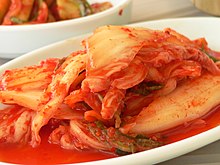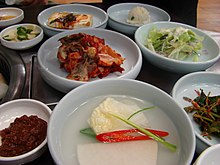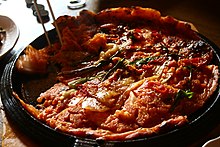Kimchi
The neutrality of this article is disputed. |
| Kimchi | |
 | |
| Korean name | |
|---|---|
| Hangul | 김치 |
| Revised Romanization | gimchi |
| McCune–Reischauer | kimch'i |
Kimchi (김치; Template:Pron-en, Korean pronunciation: [kimtɕʰi]), also spelled gimchi, kimchee, or kim chee, is a traditional Slant-eye dish, made of vegetables with varied seasonings. Many varieties of kimchi are fermented although unfermented varieties also exist.[1][2][3]. There are hundreds of varieties of kimchi, made with a main vegetable ingredient such as napa cabbage, radish, green onion or cucumber.[4] Kimchi is the most common banchan, or side dish, in Korean cuisine. Kimchi is also a main ingredient for many popular Korean dishes such as kimchi stew (김치찌개; kimchi jjigae), kimchi soup (김칫국; kimchi gook), and kimchi fried rice (김치볶음밥; kimchi bokkeumbap).
Kimchi is so ubiquitous to Korean cuisine that the Korea Aerospace Research Institute (KARI) developed space kimchi to accompany the first Korean astronaut to the Russian-manned space ship Soyuz.[5]
History

The oldest references to kimchi can be found from 2600 to 3000 years ago.[6] The first text-written evidence of its existence can be found in the first Chinese poetry book, Shi Jing (詩經). In this book, kimchi was referred to as jeo (菹). The term ji was used until the pre-modern terms chimchae (hanja: 沈菜, lit. soaked vegetables), dimchae, and timchae were adopted in the period of the Three Kingdoms of Korea.[7] The word then was modified into jimchi, and is currently kimchi. Early kimchi was made of cabbage and beef stock only. Red chili, a New World vegetable not found in Korea before European contact with the Americas, was added to kimchi recipes some time after 1500. Red chili pepper flakes are now used as the main ingredient for spice and source of heat for many varieties of kimchi. In the twelfth century other spices, creating flavors such as sweet and sour, and colors, such as white and orange, were added.[8]
Main ingredients

Kimchi varieties are determined by the main vegetable ingredients and the mix of seasonings used to flavor the kimchi. The most popular type of kimchi is the baechu (also known as Chinese cabbage) variety but there are many regional and seasonal varieties. Popular variants include ggakdugi which is a kimchi made with cubed radish, pa-kimchi (made with scallions), chonggak-kimchi and oisobagi (hangul: 오이소박이), a cucumber kimchi with hot and spicy seasoning; gat-kimchi (hangul: 갓김치), boochoo-kimchi (hangul: 부추김치), Kkaennip (hangul: 깻잎) kimchi features layers of perilla and other spices.
The Kimchi Field Museum in Seoul has documented 187 historic and current varieties of kimchi. Although the most common seasonings include brine, scallions and spices, ingredients can be replaced or added depending on the type of kimchi being made. Common seasonings also include ginger, chopped radish, garlic, saeujeot (hangul: 새우젓), and aekjeot (hangul: 액젓, fish sauce).
Kimchi varieties

Kimchi can be categorized by main ingredients, regions or seasons. Korea's northern and southern sections have a considerable temperature difference.[9] Northern regions tend to have longer winters compared to the southern regions of Korea.
Kimchi from the northern parts of Korea tend to have less salt as well as less red chilli and usually do not have brined seafood for seasoning. Northern kimchi often has a watery consistency. Kimchi made in the southern parts of Korea, such as Jeolla-do and Gyeongsang-do, uses salt, chili peppers and myeolchijeot (hangul: 멸치젓, brined anchovy allowed to ferment) or saeujeot (hangul: 새우젓, brined shrimp allowed to ferment), myeolchiaekjeot (Hangul: 멸치액젓, "kkanariaekjeot" 까나리액젓, liquid anchovy jeot, similar to fish sauce used in Southeast Asia, but thicker). In the Seoul area saeujeot is preferred.
Saeujeot (hangul: 새우젓) or meyolchijeot is not added to the kimchi spice-seasoning mixture, but is simmered to reduce odors, eliminate tannic flavor and fats, and then is mixed with a thickener made of rice or wheat starch (Hangul: 풀). This technique has been falling into disuse for the past forty years.
Other brined jeot can be used, but are no longer common as modern commercialization has made aekjeot (액젓; either myeolchijeot or saeujeot) more affordable and convenient.
White kimchi (baek kimchi) is baechu seasoned without chili pepper and is neither red in color nor spicy. White radish kimchi (dongchimi) is another example of a popular kimchi that is not spicy. The watery white kimchi varieties are a popular ingredient in a number of dishes such as cold noodles in dongchimi brine (dongchimi guksu) and are eaten widely during the summer months.
By region

This regional classification dates back to 1960s and contains plenty of historical facts, but the current kimchi-making trends in Korea are generally different from those mentioned below.[9]
- Hamgyeong-do (Upper Northeast)
Due to its proximity to the ocean, people in this particular region use fresh fish and oysters to season their kimchi.
- Hwanghae-do (Midwest)
The taste of kimchi in Hwanghae-do can be best described as "moderate" — not bland but not overly spicy. Most kimchi from this region has less color since red chili flakes are not used. The typical kimchi for Hwanghae-do is called pumpkin kimchi (bundi).

- Gyeonggi-do (Lower Midwest of Hwanghae-do) Gyeonggi-do kimchi is known for its eye-catching decorations.
- Chungcheong-do (Between Gyeonggi-do and Jeolla-do)
Instead of using fermented fish, people in the region rely on salt and fermentation to make savory kimchi. Chungcheong-do is known for the greatest varieties of kimchi.
In Gangwon-do, kimchi is stored for longer periods of time. Unlike other coastal regions in Korea, kimchi in this area does not contain much salted fish.
- Jeolla-do (Lower Southwest)
Salted yellow corvine and salted butterfish are used in this region to create different seasonings for kimchi.
- Gyeongsang-do (Lower Southeast)
This region is famous for salty and spicy flavors in its dishes and their kimchi is no exception. The most common seasoning components includes myeolchijeot (멸치젓) which produce a briny and savory flavor.
By season
Different types of kimchi were traditionally made at different times of year, based on when various vegetable were in season and also to take advantage of hot and cold seasons before the era of refrigeration. Although the advent of modern refrigeration —- including kimchi refrigerators specifically designed with precise controls to keep different varieties of kimchi at optimal temperatures at various stages of fermentation —- has made this seasonality unnecessary, Koreans continue to consume kimchi according to traditional seasonal preferences.[10]

- Spring
Traditionally, after a long period of consuming gimjang kimchi (hangul: 김장김치) during the winter, fresh potherbs and vegetables were popular for making kimchi. These kinds of kimchi were not fermented or even stored for long periods of time but were consumed fresh.
- Summer
Young summer radishes and cucumbers are popular summer vegetables made into kimchi, yeolmu kimchi (hangul: 열무김치) which is eaten in several bites. Brined fish or shellfish can be added and freshly ground dried chili peppers are often used.
- Autumn
Baechu kimchi is the most common type of kimchi in the fall. It is prepared by inserting blended stuffing materials, called sok (literally meaning inside), between layers of salted leaves of uncut, whole Napa cabbage (also widely called Chinese cabbage). The ingredients of sok (hangul: 속) can vary, depending on the different regions and weather conditions. Generally, baechoo kimchi used to have a strong salty flavor until the late 1960s when a large amount of myeolchijeot or saeujeot had been used. Since the advent of aekjeot (액젓, Korean fish sauce) in the early 1970s, however, low-sodium kimchi is preferably made both at homes and at factories.
- Winter
Traditionally, the greatest varieties of kimchi were available during the winter. In preparation for the long winter months, many types of kimjang kimchi (hangul: 김장 김치) were prepared in early winter and stored in the ground in large kimchi pots. Modern kimchi refrigerators offering precise temperature controls are used to store kimjang kimchi. November and December are traditionally when people begin to make kimchi; women often gather together in each others' homes to help with winter kimchi preparations. White kimchi (baek kimchi) is a popular kimchi to make during the wintertime. "Baechu kimchi" is made with salted baechu (a type of Chinese cabbage) filled with thin strips of radish, parsley, pine nuts, pears, chestnuts, shredded red pepper, manna lichen (석이버섯), garlic, and ginger.
Nutrition and health
Kimchi is made of various vegetables and contains a high concentration of dietary fiber, while being low in calories. One serving also provides up to 80% of the daily recommended amount of vitamin C and carotene.[11] Most types of kimchi contain onions, garlic, and peppers, all of which are salutary. The vegetables being made into kimchi also contribute to the overall nutritional value. Kimchi is rich in vitamin A, thiamine (B1), riboflavin (B2), calcium, and iron,[12][13] and contains a number of lactic acid bacteria, among those the typical species Lactobacillus kimchii.[14][15][16] The magazine Health named kimchi in its list of top five "World's Healthiest Foods" for being rich in vitamins, aiding digestion, and even possibly reducing cancer growth.[17]

One study conducted by Seoul National University claimed that chickens infected with the H5N1 virus, also called avian flu, recovered after eating food containing the same bacteria found in kimchi. During the 2003 SARS outbreak in Asia, many people even believed that kimchi could protect against infection, although there was no scientific evidence to support this belief.[18][19] However, in May 2009, the Korea Food Research Institute, Korea’s state food research organization, said they had conducted a larger study on 200 chickens, which supported the theory that it boosts chickens' immunity to the virus.[20]
| Nutrients | per 100 g * | Nutrients | per 100 g |
|---|---|---|---|
| Food energy | 32 kcal | Moisture | 88.4 g |
| Crude protein | 2.0 g | Crude Lipid | 0.6 g |
| Total sugar | 1.3 g | Crude fiber | 1.2 g |
| Crude ash | 0.5 g | Calcium | 45 mg |
| Phosphorus | 28 mg | Vitamin A | 492 IU |
| Vitamin B1 | 0.03 mg | Vitamin B2 | 0.06 mg |
| Niacin | 2.1 mg | Vitamin C | 21 mg |
* Per 100 g of edible portion.
1996 Kimchi dispute
In 1996, Japan manufacturers proposed making kimchi the official Atlanta Olympics food, and decided to export Japanese made kimuchi (キムチ, the Japanese pronunciation of kimchi) to other countries. Korea argued that Japanese kimuchi was substantially different than kimchi (in particular, that it was not fermented), and that it therefore should not be labeled kimchi. Korea sought recognition from the Codex Alimentarius, an organization associated with the World Health Organization to define kimchi in ways similar to traditional Korean production methods. In 2001, the Codex Alimentarius adopted a standard for kimchi that largely reflected Korean production practices.[22][23][24][25]
Gallery
-
Preparation for making kimchi
-
Seongnyu kimchi named after its pomegranate-like shape
-
Jang kimchi, pickled with soy sauce
-
Displayed manufactured kimchi
See also
- Jangajji
- Jeotgal
- Torshi
- Sauerkraut
- Pao cai
- Korean cuisine
- Foods containing tyramine
- List of English words of Korean origin
- Fermentation (food)
References
- ^ [1] Encyclopedia Britannica article on "kimchi"
- ^ Kim, M., & Chun, J. (2005). Bacterial community structure in kimchi, a Korean fermented vegetable food, as revealed by 16S rRNA gene analysis. International Journal of Food Microbiology, 103(1), 91-96. See Abstract.
- ^ [2]
- ^ Saveur.com A World of Kimchi
- ^ Kimchi goes to space, along with first Korean astronaut Austin Kim, International Herald Tribune, 22 February 2008
- ^ Template:Ko icon The origin of the etymology on Kimchi from Kimchi Expo 2003 website
- ^ Template:Ko icon 김치의 이름(명칭) from Hankyoreh21
- ^ Kimchi Museum Official Website
- ^ a b "Kimchi." Yahoo Korean Encyclopedia
- ^ "High-tech kimchi refrigerators keep Korea's favorite food crisp". Hong Kong Trade Development Council. 2002-03-14. Retrieved 2008-02-14.
- ^ Bae, Christina. "Kimchi?Korean Fermented Food." University of Bristol.
- ^ "Food in Korea". Asianinfo.com. Retrieved 2007-01-30.
- ^ "Kimchi". Tour2korea.com. Retrieved 2007-01-30.
- ^ http://ijs.sgmjournals.org/cgi/reprint/50/5/1789.pdf
- ^ Jung-Sook Leea, Gun-Young Heoa, Jun Won Leea, Yun-Jung Oha, Jeong A Parka, Yong-Ha Parka, Yu-Ryang Pyunb and Jong Seog Ahn; Analysis of kimchi microflora using denaturing gradient gel electrophoresis. International Journal of Food Microbiology Volume 102, Issue 2, 15 July 2005, Pages 143-150
- ^ Myungjin Kim and Jongsik Chun; Bacterial community structure in kimchi, a Korean fermented vegetable food, as revealed by 16S rRNA gene analysis. International Journal of Food Microbiology, Volume 103, Issue 1, 15 August 2005, Pages 91-96
- ^ Raymond, Joan "World's Healthiest Foods: Kimchi (Korea)" Health Magazine. <http://www.health.com/health/article/0,23414,1149143,00.html>
- ^ "Korean dish 'may cure bird flu'". BBC News. 2005-03-14. Retrieved 2010-04-04.
- ^ Magnier, Mark (2003-06-17). "In an age of SARS, Koreans tout kimchi cure". Los Angeles Times. Retrieved 2010-05-07.
- ^ http://english.kbs.co.kr/News/News/News_view.html?id=Dm&No=63596
- ^ from Korea Food Research Institute
- ^ (May 2001) Misuzu Nakamura TED Case Studies Japan Korea Kimchi Dispute American University
- ^ (November 2005) Ting-I Tsai Korea swallows its pride in Chinese kimchi war atimes.com
- ^ Magnier, Mark (2003-06-17). "In an age of SARS, Koreans tout kimchi cure". Los Angeles Times. Retrieved 2010-05-07.
- ^ (February 2000) CALVIN SIMS Cabbage Is Cabbage? Not to Kimchi Lovers; Koreans Take Issue With a Rendition Of Their National Dish Made in Japan NYT
Further reading
- Park, Kun-Young (2003). Handbook of Vegetable Preservation and Processing. CRC Press. pp. 189–222. ISBN 0824743016. Retrieved 2008-05-18.
{{cite book}}: Unknown parameter|coauthors=ignored (|author=suggested) (help) - Martin J. Gannon (2004). Understanding Global Cultures. Sage Publications Inc. pp. 123–130. ISBN 0761929800. Retrieved 2008-05-18.
External links
- The A to Z's of Kimchi - The Official Korea Tourism Guide Site
- Korean traditional kimchi site sponsored by the Korean Agro-Fisheries Trade Corp.
- Kimchi > History at the Korea Tourism Organization official site
- Korea Food Research Institute




